Blooming shrub is just a find for any plot or garden. And if this plant has an incredibly beautiful appearance, he is destined to become a central decoration anywhere. It is to such shrubs or trees that pleasing to all lush flowering, relates Rhododendron.
This exotic handsome man has bright appearance and very beautiful colors, so will certainly like many. But not everyone can grow such a miracle, because Rhododendron has accustomed to certain conditions that are not so easy to create in our climatic zone. If you caught fire to grow rhododendron on the plot, then our article will help you do it right.
In this article we will look at the features and description of Rhododendron, we learn about the most popular and common types and varieties of this beautiful shrub. And also we will tell you about the main nuances of agrotechnics of cultivation in the conditions of our climate.
Features and description Rhododendron
Rhododendrons belong to the major family of drowns and are evergreen, nominated footpaths and leaf falling shrubs or trees. The first mentions of this plant belong to 1753, when Karl Linny allocated 5 species in one family. Although in the 16th century were described by Karl Clusus. After some time, doubts arose with the inclusion of a family of azalei. However, it was then decided, in particular in 1836 by Socials of Salisbury and Teit, to make azalia to the genus Rhododendron and divide them all into several groups. Now often on the windowsill, you can find blooming azals, which are also rhododendons.
These exotic plants grow mainly in the temperate climate of the northern hemisphere. Frequently blooming rhododendrons can be found in Japan, China, in Himalayas, South Asia and North America. Also, some species can be found in Australia and in Guinea. In Russia, Rhododendron meets in nature. Approximately 18 species are growing in the Caucasus, Siberia and the Far East.
Rhododendron description:
- Rhododendron grows in the form of evergreen shrubs, leaf falling shrubs and sometimes trees.
- In nature is found in single and group landings.
- May grow on the slopes of the mountains and in the undergrowth.
- Very loves the conditions of high humidity, so sometimes it becomes problematic to grow this plant in our sites.
- The root system of this plant is superficial and has a large number of branches. Usually, without any problems react to a transplant.
- Rhododendrons shrubs in nature can grow at a height of 10-100 cm, and trees - up to 30 m.
- Garden rhododendrons are represented by shrubs that have quite compact sizes.
- In the form of rhododendrons, evergreen and leaf falls can be fluttered and represented.
- Depending on whether a leafy shrub or evergreen, rhododendron leaves can be annual, two-year and perennial.
- In the form of the leaves there are an oblong form, more often egg-shaped or inversely. With jeeded sawdords or solid. Sometimes leaves can be published. The color can be from light green to dark green.
- Located leaves also differently. In some types of spirals, sometimes there are next.
- The main decoration of Rhododendron is his flowers.
- Rhododendron flowers are of different sizes: from 3 cm to 20 cm in diameter.
- They are assembled into large thyroid or private inflorescences, which during flowering resemble beautiful bright bouquets growing right on the bush. Long can stand in water in a cut form.
- Flowers are different colors: pink, purple, purple, white, red.
- In the form of flowers also differ. Depending on the specific type and varieties can be in the form of a funnel, bell, wheels, pipes.
- Rhododendron's fruit is a leathery five-grated box, which is revealed from top to bottom. Seeds are very small - up to 2 mm.
- All Rhododendrons are excellent honeycomb.
- Translated from Greek Rhododendron denotes a "pink tree", and in Japan it is often referred to as the temptation tree.
Popular views and varieties Rhododendron
In total, there are more than 1,000 different types of rhododendrons, which, in turn, are also divided into many subspecies. About 60 species are cultivated in Russia, and in nature there are 18 species. In addition, they are all listed in the Red Book and are rare plants.
Consider the most common types and varieties of Rhododendron.
Rhododendron dense
- It is an evergreen rhododendron, a low shrub.
- The natural habitat is considered China, where more than 2 thousand meters are growing at an altitude.
- In height can reach only 30-50 cm, while forming a spherical compact crown. Grows slowly.
- The leaves of this type of rhododendron are oblong, up to 2.5 cm long.
- Flowers bright purple-blue flowers that bloom in May.
- This type of rhododendron is frost-resistant.
Popular varieties:
- Sort "Azurika". It can grow up to 40 cm. Flowers with bright purple blue flowers.
- "Krumlov". Flowers with lilac flowers. In height can reach 50 cm.
- Blumes. Pleases the eyes with blue flowers.
- "Lizella". Flowers with small pink colors.
Rhododendron Catavbinsky
- It is an evergreen shrub, which is formed by long branched shoots.
- Height can reach 2-2.5 m.
- Leaves from this species are simple, oblong, dark green.
- Flowers are very beautiful in the form of a funnel, a bright purple shade.
- All flowers are collected in big inflorescences.
- Flowers Rhododendron Catabinsky at the end of May and pleases his lush flowering bush for a month.
- Per year can grow by 10 cm. Is a long-liver.
Popular Rhododendron Catiavbinsky varieties:
- Album Novum. Tall shrub, can grow up to 3 m. Flowers beautiful white flowers with yellowish-green streaks.
- "Grandiflower". Flowers with lilac-lilac flowers.
- "Roseum Elegance." Pink flowers with red speck.
Rhododendron Yakushimansky
- The natural habitat is the territory of Japan.
- From this type of Rhododendron there is a large number of modern decorative varieties.
- A small compact shrub, which in height can reach 1 m.
- Leaves are narrow and oblong, dark green.
- Blossom starts in May.
- At the very beginning of flowering, the flowers of a gentle pink shade, at the end become white.
- Enough frost-resistant look.
Popular varieties:
- "Almouth". Evergreen shrub, blossoming white flowers in red speck.
- "Arabella". Large colors of a red shade with a white core and corrugated edge.
- "Astrid". Red flowers of rather large size.
- "Marrakesh". It has enough low growth. Flowers soft salmon flowers.
Rhododendron Daursky
This kind of rhododendron in nature grows in the Primorsky Territory, in China, Korea and Siberia. It can be found on the rocks and in coniferous forests.
- It is an evergreen shrub, which height can reach 2-4 meters.
- Shrub is very branched.
- The leaves are small and oblong, in the length of only 3 cm. In the spring and summer there are a light green or dark green shade, and the fall of Rhododendron Daurry is painted in reddish-green and brown colors.
- Flowers shrub large, up to 4 cm in diameter, flowers, in shape resembling funnels. Flowers of gentle purple pink color.
- This type of rhododendron perfectly transfers heavy cold.
Popular varieties:
- "Eypril Down." Fall shrub, blooming beautiful terry flowers of pink shade.
- "Double White." Rhododendron shrub with terry snow-white flowers.
Rhododendron Shlippenbach
- A leafy shrub that is formed weakly branching shoots.
- The height reaches 1.5-2.5 m.
- Blossom starts in mid-May.
- Flowers are large, up to 8 cm in diameter. Have a gentle light pink color with purple specks inside.
Rhododendron Caucasian
According to the name, the natural range of growth of this type of Rhododendron is the territory of the Caucasus.
- Evergreen shrub, which height can reach 1.5 m.
- The shrub is formed with the help of sharp shoots.
- The leaves are small oblong, dark green, on the reverse side are slightly pubes with a reddish pile.
- Blossom starts in mid-June.
- Flowers of yellowish and white shade, small in diameter.
Popular varieties:
- Cunninghams White. A sufficiently high shrub blooming with white flowers with purple clips.
- "Riga White". Differs in pure white flowers.
Rhododendron Japanese
The birthplace of this beautiful type of shrub is Japan.
- It is one of the most popular deciduous rhododendrons.
- It is a high shrub with sufficient branched shoots.
- Leaves are oblong, oval. In the summer of a green shade, and the autumn becomes bright orange-red.
- Flowers are large, in diameter reaches 8 cm. Have a rather unusual color: orange or salmon.
- Collected usually in large inflorescences on average 10 pcs in each.
In addition to those listed on sites, it is often possible to meet Rhododendrons of the following types: Rhododendron tree, yellow, Kamchatka, Canadian, largest, largest, pink, smirnova and others.
Methods of breeding Rhododendron
Rhododendrons can be breed different ways. Suitable as seed and vegetative. Most often at home, three ways are used: the reproduction of seeds, stalling and tanks.
Rhododendron seeds reproduction
This method of breeding rhododendrons is rarely used. Most often, it is used by breeders to eliminate new species and varieties of culture, as well as seeds you can multiply wild rhododendron varieties. This is a rather long and time-consuming process.
- Optimal time for sowing Rhododendron seeds - Spring. This is approximately the end of February - the beginning of March.
- In advance before planting seeds, it is possible to germinate at a temperature of 20 degrees. Also, as an option, they can be subjected to stratification - 1 day in the refrigerator. Or treat seeds with special preparations.
- Next prepare for sowing seed nutritious soil. Take suitable containers or boxes and fill in them with a wet-up peat or heather ground. From above you can add sand. The soil mixture can also be treated with a weak solution of manganese.
- The smallest seeds can only be scattered over the surface, not sprinkling and not blunting. Larger must be sprinkled with a thin layer of sand.
- After sowing the soil, it is necessary to pour up with soft water. You can use rain or slightly acidified by the oxalic acid of ordinary water.
- From above, the boxes are covered with glass and put containers on a well-lit place.
- After 3-4 weeks, the first shoots appear at room temperature, then they must be moved to a room with a cooler temperature.
- After the growing seedlings, seedlings are picked, on winter it is possible to turn on additional lighting.
- The first bloom of rhododendrons grown from seeds, you will see only 6-8 years old.
Rhododendron breeding breeding
This method is much easier than the previous one.
- In deciduous rhododendrons, the cuttings are cut from annual green topless shoots.
- If you have an evergreen shrub on the plot, then use semi-respected shoots to get planting material.
- The average length of cuttings should be 8-10 cm.
- It is necessary to remove the lower leaves, leaving only a pair of top.
- Before planting in the ground, all cuttings are treated with a special solution of the root formation stimulator (12-16 hours), since the rooting occurs very slowly.
- Dry cutlets in greenhouses or greenhouses in the prepared ground. The main thing is that there was no direct sunlight.
- On average, rooting takes from 1.5 to 4.5 months.
- Care lies in periodic moistening of soil and ventilation.
- For the winter, the cuttings are placed in a greenhouse, a winter garden or another closed place.
- The next year they can be planted for a permanent place.
Rhododendron reproduction
This is another way of vegetative reproduction of rhododendrons. It is perhaps the easiest option.
- In an adult and healthy rhododendron bush, you need to choose a lower flexible escape.
- Then it makes a small longitudinal incision.
- A special groove is broken under a bush, about 12 cm deep into the depth.
- Selected shoots are thrown into the ground and stacked in the groove. After that, soil is sprinkled.
- Next, the seating material should be abundantly pouring water.
- In the fall or spring, after rooting, seedlings are disconnected from an adult plant and transplanted to a permanent place.
Stages of preparation before landing Rhododendron
To obtain a beautiful and magnificent blooming shrub Rhododendron, it is necessary to carefully prepare, especially since this culture is quite picky. It is important to choose the right place for planting and acquire a high-quality planting material. Important is the correct soil preparation.
Stage 1. Selection of rhododendron saplings
Buy Rhododendron can be in a specialized store or nurseries. There are several options for the purchase of rhododendron saplings: with an open root system and closed. Each planting material has its pros and cons. Buckets with open roots are easier to explore and see damage. And seedlings with a closed root system are better to transfer transportation and can be kept for a long time.
Before purchase, be sure to carefully inspect the plant. It should not be broken or damaged shoots, yellow foliage or dry roots.
It is also not recommended to buy rhododendron saplings in the natural markets and with hands. So you risk getting not exactly what they wanted. It is necessary before purchasing the planting material, decide on the planned garden composition and suitable cultural varieties for it.
Stage 2. Selection of Places for Rhododendron
It is very important for the full growth of Rhododendron to choose an optimal place, and it is not so easy to do. In nature, these shrubs grow on the slopes of the mountains and love increased moisture. In addition, each type of this culture requires special individual growth conditions.
- The place must be protected from strong winds.
- It is also important that straight sun rays do not fall on the shrub.
- Almost all rhododendrons prefer easy half, some love mostly solar places. In no case cannot land this culture in the shade.
- It is also important to take into account the level of groundwater, it should not be closer than 1 meter.
- The neighborhood of various trees is not unimportant for the growth of Rhododendron. Choose a place next to the cultures that have a root system that go deep into. These are apple trees, pears, pine, oak. In no case do not fit this culture near the linden, maple, chestnut. These trees will take all nutrient elements.
Stage 3. Soil preparation for Rhododendron
Rhododendrons prefer to grow on acidic soils, it is precisely such conditions for this culture in nature. Therefore, if there is insufficient soil acidity on your site, then it is necessary to acidify it. To do this, it is necessary to add oad of coniferous trees to the soil mixture. Optimal acidity should be 4.5-5.0.
If you have a high groundwater running on your site or a landing place is in lowland, it is advisable to raise the garden, using the mound from the soil. It will not be superfluous and a good drainage layer.
The process of landing Rhododendron
- The best time for planting Rhododendron saplings is spring.
- First, decide which composition you want to get. It is better to plant a group, so you will not need to cook a few holes.
- Next, be sure to prepare the soil mixture suitable for this culture. The optimal combination will be optimal: leaf land, riding peat, oad of coniferous trees.
- You can add a little mineral fertilizer to the ground, but consider that excess it is undesirable for Rhododendron. The usual dose for plants boldly reduce 2-3 times. It is impossible to add manure and compost.
- Prepare landing pits. In depth, they should not be deeper than 50 cm, and in width it is better to do more, since the root system of culture surface. Approximately in width you need to do 60-70 cm.
- Between the plants there should be a distance of 0.7-2 m.
- Place a good layer of drainage on the bottom of the pit. As a drainage, you can use broken brick, gravel and small stone.
- Watch the container with seedlings in advance with water and carefully remove the bushing.
- Next, place it in the pit and suck the earth, not too blocking the root neck.
- After landing, it is plenty of seedling with water and inspire the soil around the pine bark.
Features of the care of rhododendron
After landing Rhododendron needs constant and attentive care. It includes watering, feeding, loosening, trimming and shelter for the winter.
Watering Rhododendron
Rhododendron requires regular and moderate irrigation. In hot time, the frequency of irrigation should be increased. On one plant should leave 10-12 liters of water 2-3 times a week. Use better rainwater or specifically acidify water. Also, the plant loves spraying, especially during active growth. However, it is not recommended to spray during flowering.
Falker Rhododendron
Rhododendrons prefer liquid feeding. The first is introduced early in the spring, and the last after the appearance of young shoots. In these periods, you can make a water manure solution. In the spring of mineral fertilizers, it is preferable to make nitrogen-containing in a small dosage. In early June, you can make a sulfate ammonium, superphosphate and a little potassium. With potassium, you should be careful and add quite a little. At the end of July, you can make superphosphate. Before feeding, you must water the soil around the plant, so as not to burn the roots.
Rhododendron Rhododendron
It is not recommended to loose rhododendrons at all, since the root system of this culture lies close to the surface. And loosening can contribute damage to the roots. Manual weeding of the rolling circle is allowed. After that, it is necessary to inspire the soil with peat or pine bark.
Trimming Rhododendron
During flowering, it is advisable to trim faded buds to stimulate the growth and flowering of new ones. Rhododendrons do not need necessarily trimming, however, if you want to form a crown, you need to do it in early spring before the start of the blooming of the kidneys. Use the sharp secateur and remove only a part of the shoots.
Rhododendron Shelter for Winter
Among the entire variety of species and varieties of Rhododendron there are many winter-hardy instances. However, still should not be neglected with additional shelter. The warming of rhododendron for the winter includes the shelter of the rolling circle with a thick layer of peat and spruce legs. Also at the end of the autumn, it is necessary to cover the entire bush of burlap, pre-all the branches by placing fir legs. Bottom burlap roll up with a rope. It is necessary to shoot it after the snow.
Fighting pests and disease Rhododendron
Rhododendron shrubs become a favorite place for various pests:
- Cute tick. You can see on the inside of the foliage, which it covers the web. After this foliage becomes drowato-red and falls. To combat it, you need to use Diazinon.
- Weevil. This pest is able to seriously harm the plant. They feed on leaves, kidneys and buds, and their larvae spoil the bark. To combat them it is necessary to spray not only the plant, but also the soil around it.
- Mealybug. This pest can lead to the death of the entire plant. To combat it, carbofos is used.
- Slug and snails. Going to manual.
In addition to pests, various diseases are tested for rhododendrons.
- Chlorosis. With this fungal disease Rhododendron turns yellow. The reason may be the lack of nutrient elements or stagnation of water in the roots. For treatment, it is necessary to use fantasics with iron and magnesium sulfate.
- Rot. This is a severe disease that can very quickly lead to the complete death of the plant. The affected areas must be trimmed. If the roots are infected, the plant is digging and burned. To prevent the appearance of this disease, burglar liquid is used.
Using Rhododendron in Landscape Design
All types of rhododendron are widely used in landscape design. The following applications are possible:
- Single landing. They look great soliters on the background of a green lawn, especially the lowest varieties.
- The use of rhododendrons in Japanese gardens. Perfectly look in combination with green shrubs and trees.
- Garden compositions. Rhododendrons are spectacular in combination with other blooming shrubs. For example, in the neighborhood with spirires and hydrangea.
- Group landing rhododendrons. In this case, it is necessary to select grades in the height of shrubs and painting colors.
Photo Rhododendron in Landscape Design
You can more clearly see all the features of the use of this culture in the decoration of the site on the presented photos.
Single landing:
Use in combination with other blooming plants:
Group landing of different varieties of Rhododendron:
Rhododendron is a bright and spectacular shrub that will make your plot with more original and exotic. All efforts spent during the cultivation of this shrub will pay for you with a storm when it is lush flowering.

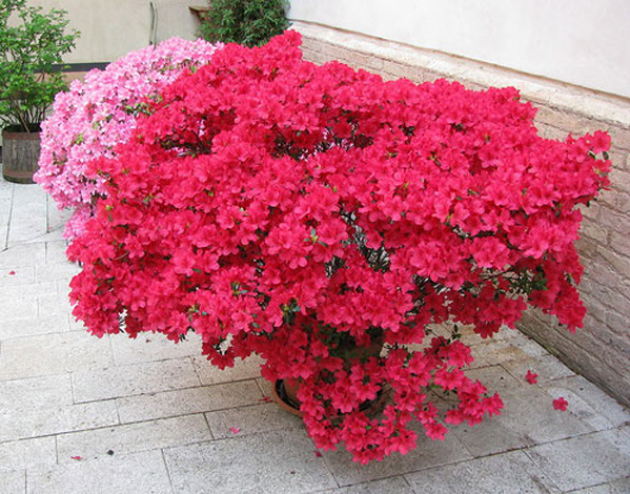
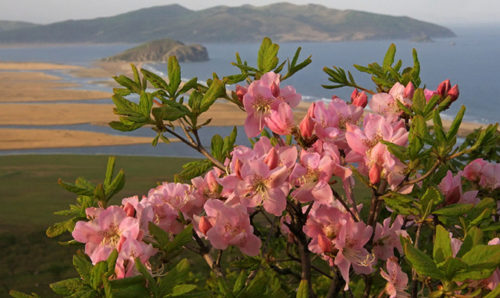
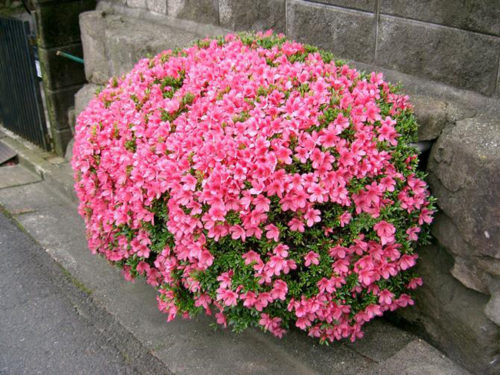
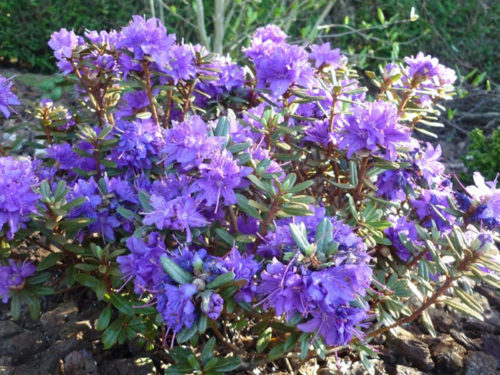
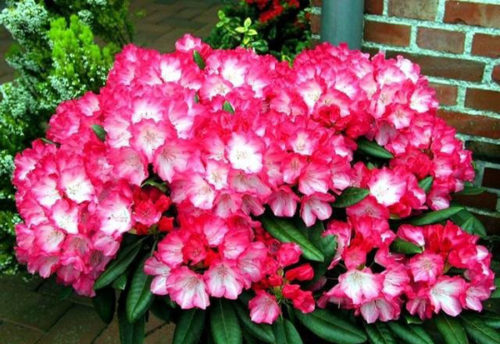
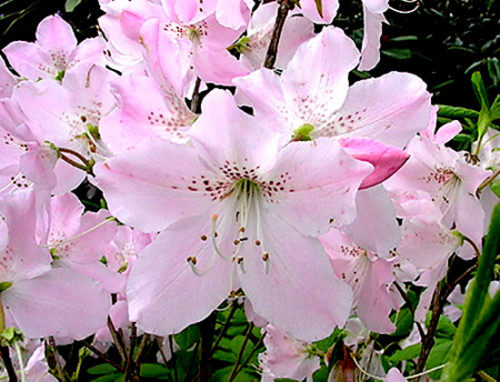
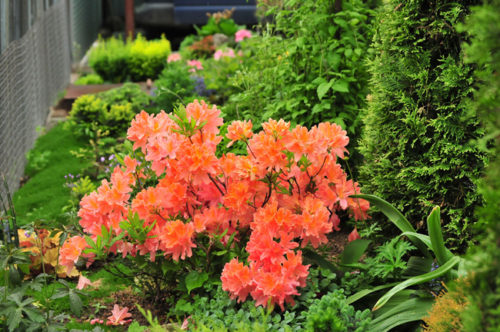
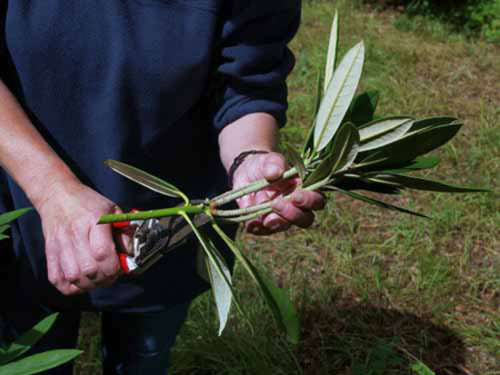
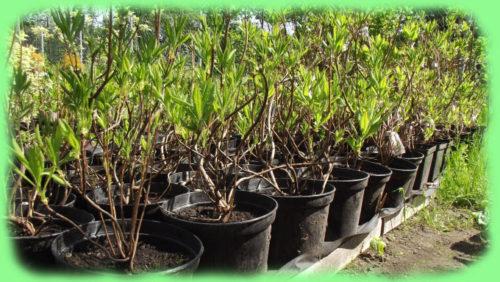


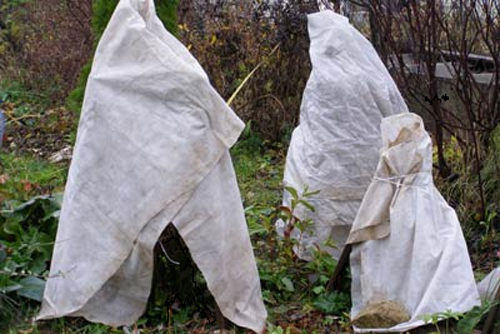
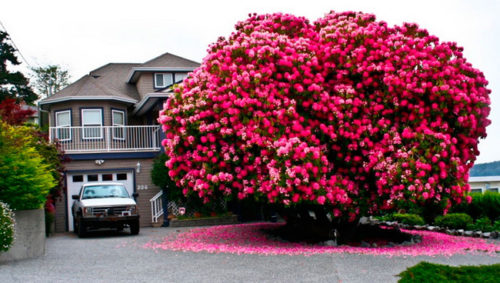
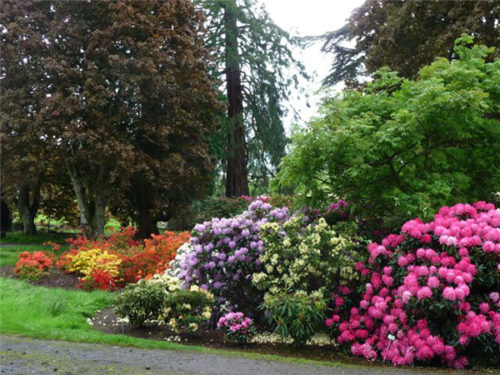
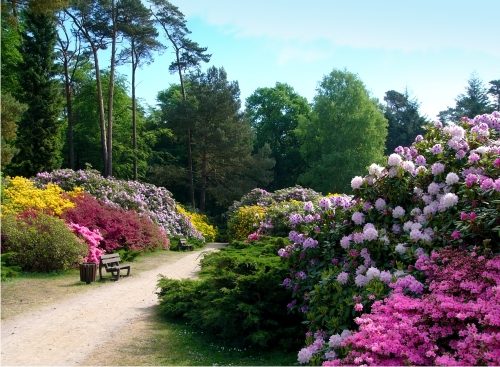












 Start a discussion ...
Start a discussion ...